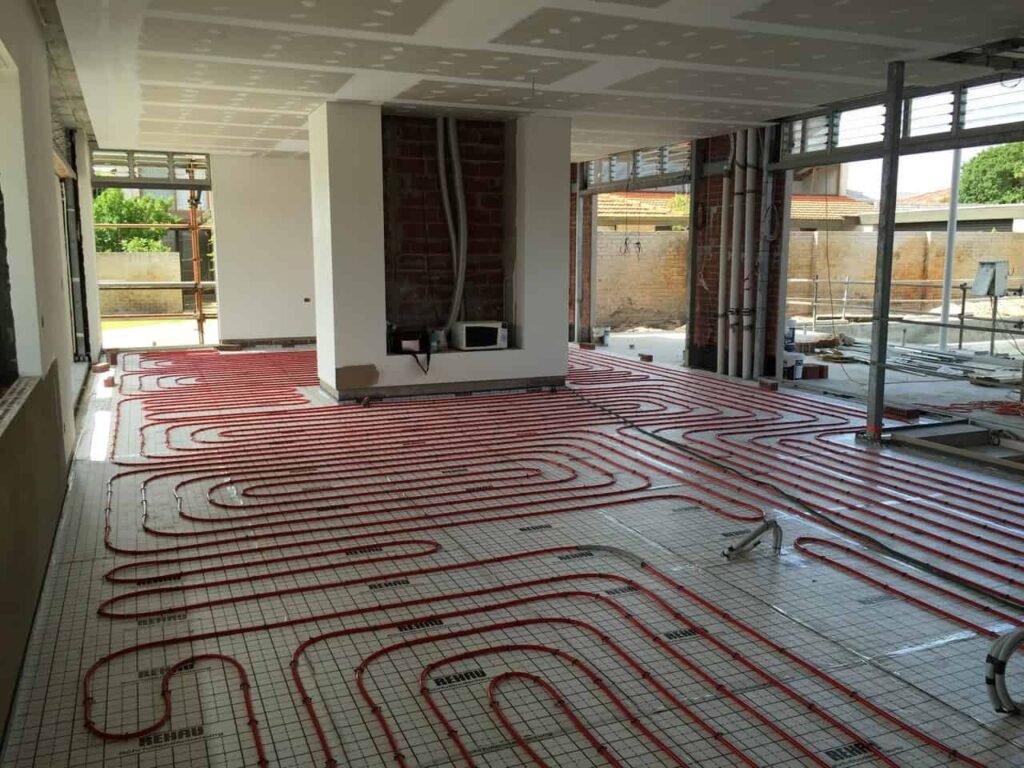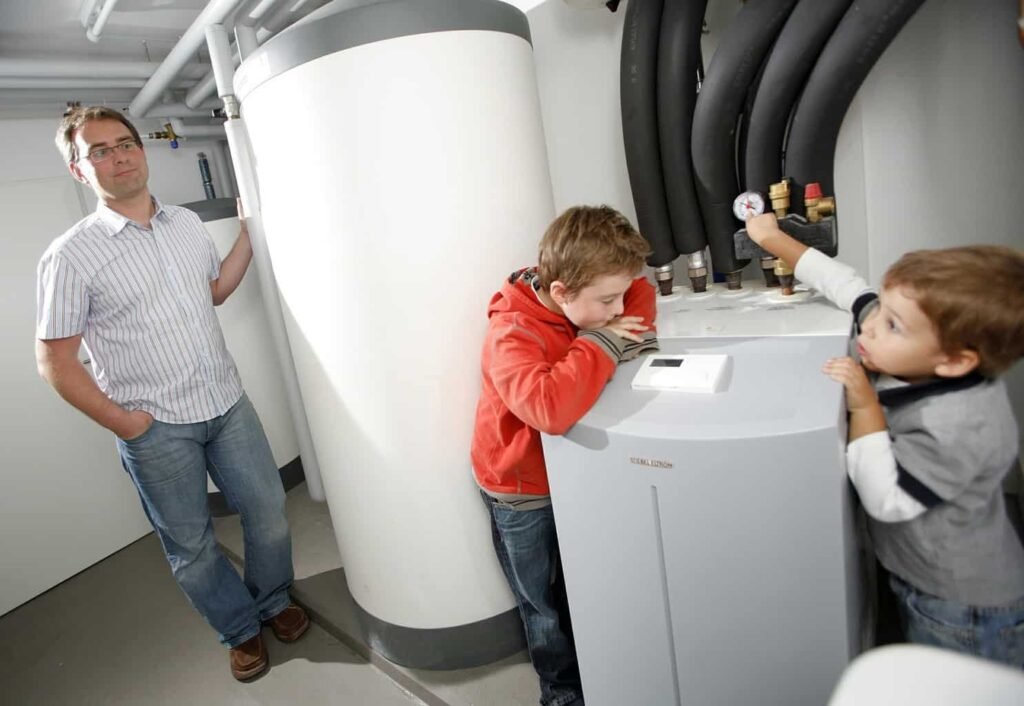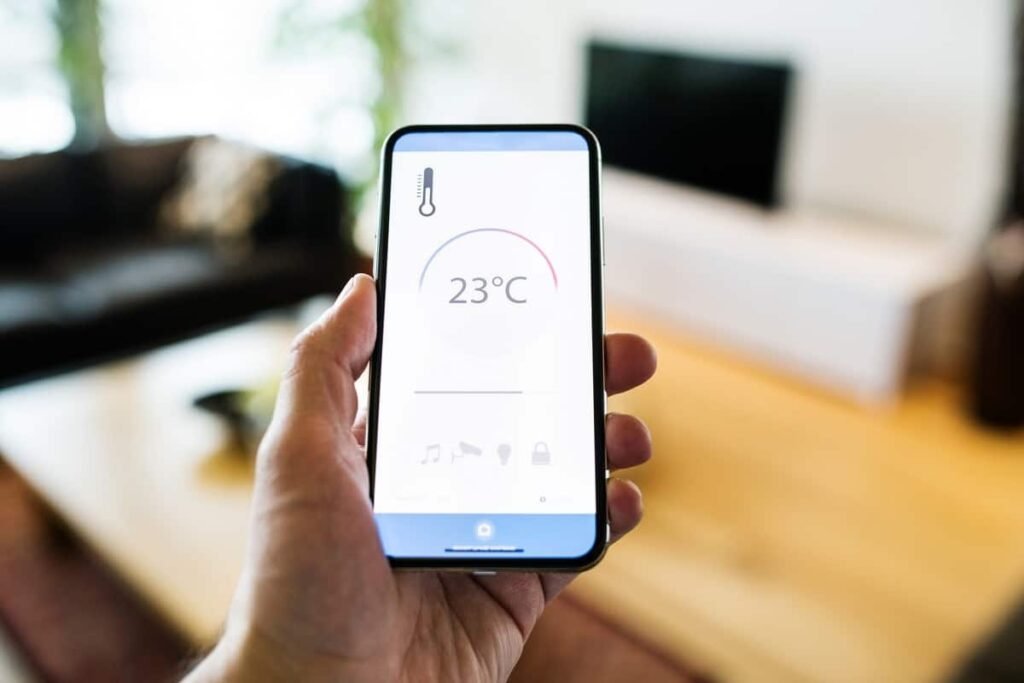1. Can the pipes leak… and what happens if they do?
Floor heating pipes can only leak if they are cut or punctured – which means someone has to physically drill, cut or penetrate them. They will not burst or leak by themselves (they have a lifespan of up to 100 years, and are extremely durable). Sometimes penetrations do occur by accident on site, however, it is immediately recognised as water squirts out of the penetration (the pipes are pressure tested after installation, and remain pressurised during construction). The pipe can be repaired, and good brands of pipe guarantee their repair even when covered again with concrete.
2. Can I use floor cooling instead of aircon?
Generally in our Australian climates, floor cooling is does not cover the required cooling load of the building. This is partially due to the way we build our houses in Australia (lots of glass windows and doors, varying levels of air-tightness and insulation), but also because there is ‘latent’ load which needs to be removed from the air (heat held in air moisture), and mainly due to the fact that physics works against floor cooling, because cool air remains close to the ground and warmer air remains above this uncooled. Floor cooling output can be between 20-50W/m2, whereas the cooling load for typical houses can be around 150W/m2, and for more energy efficient house around 70W/m2.
3. Do I really need thermal insulation?
You don’t have to install thermal insulation (other than what’s required according to the building code), but this means that vast amounts of heat will escape to the surrounding environment where it’s colder (such as the outside air, the ground below, other solid structures nearby)… this is where the heat wants to naturally travel to the most – where it’s coldest. Therefore, preventing the heat from travelling to where you don’t want it to go – and directing it into the rooms where you do want to heat – will ensure your system heats as you would like it to, within the running cost that you expect.
(And no, Perth’s “dry sand” is not an insulator – it still conducts heat at a level many times greater than polystyrene insulation (for example).
4. Do I still need other forms of heating in the house?
Some people think that floor heating is only there to take the edge off cold concrete floors, and other heaters are required to keep the house comfortable. This, however, is not true. A well designed and installed heating system covers 100% of your heating requirements effectively and efficiently.
5. Can the same system supply my tap hot water?
Yes, however, this must be planned for from the start, and usually additional equipment is required. This is a good option for people wanting to minimise the amount of equipment installed at their houses.
6. What is the running cost per hour for hydronic floor heating?
This depends on 4 main factors:
1. The thermal efficiency of the building (how much heat it loses and how quickly).
2. The design and installation of the hydronic heating system (how well it produces the heat, how well it moves the heat to where it’s needed, and how well it emits the heat into the rooms).
3. The heat source type (gas boiler, air-source heat pump, geothermal heat pump, etc.).
4. What the input price of the energy is (gas, electricity, waste heat, etc.).
From our experience if the entire system is designed and installed to perfection, the system can cost between $0.162 and $0.378 per hour of operation per 100m2.
We have also seen some poorly designed and installed systems which cost upwards of $3.60 per hour of operation per 100m2.
7. Is hydronic floor heating cheaper to run than electric floor heating?
Simply put, yes. There is only one way to warm up the electric cables in the floors, and that is by running electricity through them. Because the cables provide resistance to the electricity flow, they heat up (just like your kettle does). The efficiency of this method is around 99% (meaning for every 1.0kW of electrical input, you get 0.99kW of heat output). Even if you have free PV solar power input, you are still limited to the low efficiency of the heat generation (1.0kW of free solar power = 0.99kW of free heat).
With hydronic heating, the heat can be created by a large number of processes (gas boiler, heat pump, bio-fuels, solar, etc). The heat created is then transferred to the water which runs through your floors. If we consider a well designed and installed floor heating system with a heat pump as the energy source, the efficiency will be 450%. This means that for every 1.0W of electrical input, you receive 4.5kW of heat output – meaning that in this situation, the running cost is 4.5 times lower than electrical floor heating… and if you have a PV system, every 1.0kW of free solar power = 4.5kW of free heat.
8. Is hydronic floor heating cheaper to run than reverse cycle heating?
If the design and installation of your hydronic floor heating is poor, then your floor heating system will cost many times more to run compared to your aircon heating.
If designed and installed correctly, and depending on your energy source (e.g. gas boiler or heat pump), a hydronic floor heating system will cost either the same amount to run as reverse cycle aircon (basic hydronic system), or up to 40% less (best hydronic system). This is mainly due to the fact that with aircon, you suffer from air stratification (meaning the warm air rises to the ceiling, whilst cold air stays down below), and you are relying on the warm air touching your skin to warm you up (whereas with floor heating, your body is being warmed by radiation emitted from the floor, which is a much more effective mode of energy transfer).
9. I only want to heat my bathroom floor – can I use hydronic?
You can use hydronic, but the initial investment cost will be very high for such a small heated area. For areas less than 35m2 it is generally best to use electric floor heating – even though there is a much higher running cost with electric floor heating, the saving on the initial investment will offset this for many years.
10. Should I heat my whole house, or only parts?
The most common feedback we hear from clients that have not heated their entire house (they have left out the laundry or a hallway for example) is that they wish they had heated their entire house. Sure, leaving out a room or two may save you a couple of thousand dollars – but every time you walk into those unheated rooms you instantly feel the unpleasant cold.
11. Should I/can I zone my floor heating system?
Yes, you can zone your system electronically, by having a separate thermostat timer for each zone. This means you can set up different automated running times and temperatures for each zone. We have, however, found that when clients choose to zone their systems, they usually run almost all of them on the same schedule – negating the need for the additional controls (and money spent).
We would recommend only zoning large areas, not individual rooms – for example, in a two-level home, have each level as one zone. For very large single level homes, perhaps split the house into two zones.
For rooms that are seldomly used (e.g. guest rooms), the area can manually be turned off at the heating manifold (similar to turning off a tap).
12. How long does it take to heat up?
This depends on your method of construction, and whether it’s the first day of the heating season, or you are a few days/weeks/months into it.
The more thermal mass you have to heat up, the greater the thermal inertia, and therefore the more energy (and time) required to heat the rooms up. So an insulated screed that is 60mm thick can take ~15-30mins to heat up, and an insulated on-ground slab (125mm thick) can take 30-60mins to heat up.
The first few days of the heating season it takes longer to heat the rooms up. This is because the floor is completely cold, and so are all the walls, ceiling, furniture, etc. (the floor heating radiates heat to these objects, therefore warming them up and making them into heat emitters too).
13. Can I have carpet or timber over my floor heating system?
Yes, but this requires planning beforehand, and should not be installed as an afterthought, because the system may not function well, and in worse-case scenarios it can ruin your floor finish. The easiest floor finishes to include with a floor heating system are hard – such as polished concrete, stone, or tiles. This is because they are good conductors – and if unheated, they are dead cold.
Carpet, timber and other thermal resistive floor finishes aren’t as obvious when heated – but they still make all the difference in the room (between having a cold uninviting room and a naturally warm and comfortable feeling room).
Euroheat has successfully been installing floor heating under all floor finishes in Australia for almost thirty years.
14. Will my polished concrete floor crack if I have floor heating installed?
If the system is designed and installed properly, and care is taken with the preparation of the slab, it will not have surface cracking due to the floor heating. The floor heating piping must be at a specific depth within the concrete (or deeper), and the steel reinforcing mesh as close to the surface as possible. Expansion joints will most likely be required – collaboration between the structural engineer, the concreters and the floor heating contractor is required.
Euroheat has been successfully installing floor heating into polished concrete floors for almost 30 years
15. Does the hydronic system require maintenance?
If you’d like to extend your system warranty and keep your heating system at its peak, we recommend a service every second year.
We have installed hydronic systems 15 – 20 years back, where the clients are only now asking us to do some maintenance – otherwise they have been running without fault with no attention paid to them.
16. Will the heat travel from the lower floor upstairs to the upper floor?
Some of the heat from the floor heating system is transferred to the room air (but the majority is emitted as heat radiation), and therefore this warm air will rise upstairs…. But the majority of the heat will stay on the lower floor.
You are more likely to get heat rising from the lower floor to upper floor if your lower floor air is heated from sunlight, or you have some type of forced-air or convection heating system.
17. Can solar hot water panels help with my floor heating system?
Solar hot water panels are great because they provide free heat – but usually they provide this heat when you need it the least (summer), and when you need it the most on cold winter days/nights, the sun is not shining much. So you actually run into the problem of having too much heat in summer (or even warmer spring/autumn days), with nowhere to send it. We recommend the integration of solar hot water panels only if you plan to heat your pool (this way the excess heat in summer can be dumped into the pool instead of wasted).
18. Can I use PV solar power with my floor heating system?
Yes! It is great to combine a heat pump (which uses electricity as an input) with a PV system. The trick is to have the right amount of solar power output relative to your heat pump input, and also being able to use the PV energy at the right times (there’s no point in having a PV solar system combined with your heat pump if the solar system produces energy during the day, and the heating system is only used at night).
19. What is the warranty on a floor heating system?
Each part of the system has its own specific warranty, for example:
– Floor heating pipes from 10 to 25 years.
– Manifolds 10 years.
– Boilers from 2 to 5 years.
– Thermostats/Controls 1 year.
– Heat pumps from 2 to 5 years.
Euroheat provides a 7-year warranty on all workmanship, and provides on-going help and system support for all customers.
20. How much does hydronic floor heating cost?
Depending on the method of installation (in-slab, in-screed, timber-batten), the energy source (condensing boiler, air/water heat pump, geothermal heat pump), level of controls and a host of other variables, hydronic floor heating systems can cost anywhere from $80m2 to $300m2 (designed, supplied, installed, tested & optimised).
21. Are there building codes regulations that I need to know about with hydronic floor heating?
Yes – but these are often ignored by builders (to their own detriment).
There are different requirements for residential and commercial buildings, but for residential, the regulations regarding on-ground in-slab heating systems is the most important:
– Australian Standard 2870 (5.3.6) stipulates that the thickness of the heated slab must be increased by 25mm, and the reinforcing mesh upgraded by one level (e.g. from SL62 to SL72).
– Section 3.12.1.5 of the National Construction Code stipulates that “an in-slab or in-screed heating or cooling system must be insulated around the vertical edge of its perimeter with insulation having an R-Value greater than or equal to 1.0; and the Insulation required … must be water resistant; and be continuous from the adjacent finished ground level— to a depth of greater than or equal to 300 mm; or for at least the full depth of the vertical edge of the concrete slab-on-ground (see Figure 3.12.1.4).”
There are also further specific clauses related to the heat source, and the distribution of the generated heat. Your chosen installer must adhere to all the relevant regulations.
22. Can I utilise the heat source for my pool heating during summer?
Yes you can. The heat source sends heat to the pool (via a heat exchanger) instead of your floors during summer. To maximise efficiency and minimise running costs, we would recommend only using a heat pump for this purpose (and it’s even better if you combine this with PV solar power).
23. Can I combine with aircon?
Because heat pumps can also produce chill (in addition to heat), this cold water can be utilised to cool the air in your home via ducted air-conditioning. For your typical residential home it is currently still cheaper to install totally separate floor heating and aircon systems. For larger buildings, or buildings where there is not much space for services (such as multiple aircon/heat-pump/hot-water units), there is value in combining the floor heating and aircon.
24. How will I know how to use my floor heating system?
Good floor heating systems are set-up so that they are “set and forget”. You set the system up once, and perhaps make a few adjustments during your first year to get the natural warm feeling just right. Then every year after, you turn the system on at the beginning of the heating season, and it automatically keeps your house warm during the hours you have chosen and to the specific temperature you like.
At the beginning of the first winter in your new home, Euroheat will visit and explain the entire system to you, and help you set up the thermostat controls so they work to your particular preferences.
25. Your quotation is higher than other quotes I’ve received, why are you more expensive?
The difference between our work and the work of other floor heating companies (or plumbers) is the size of the electricity or gas bills you will be paying for the rest of your life.
If you want to have just a warm floor in your house, then pretty much anyone can install the floor piping (even you yourself) and attach a heat pump or gas boiler.
But then a few months later you get the power or gas bill.
And you will fall over from shock, and decide to never use the floor heating system again.
This is not theoretical – we see this happen every year: the floor heating system can be creating warm floors in the building, but because the company that installed it just put some pipes into concrete and attached a gas boiler or heat pump (without considering the physics), the heat source is working at low efficiency and the energy is just leaking out everywhere.
26. Is it really that important which brand pipes/boiler/heat-pump are used… aren’t they all the same?
You know that when you have hydronic floor heating, you have pipes with water in them embedded within the floor on the ground level and perhaps the first floor too.
And since you have water running throughout the house in these pipes, the last thing you want is the pipes to leak out water onto the walls, furniture, documents, floor finishes, art, etc.
The pipes from almost all manufacturers are made from a similar type of quality plastic, and as such are not going to unexpectedly break and leak water all over your house.
But the weakest element of any piping system is any joins that may be required in the pipes.
And that’s why we choose the pipe manufacturer not on the quality of the pipe itself, but rather on the quality of the joins.
And since we have been doing this for almost 30 years, we know which manufacturers joins may potentially leak, and we also know which manufacturers that produce technically the best quality joints that are guaranteed to not leak, and that you can trust your house with – not for only for a few years, but for decades.
Yes, the heat pump or boiler is going to heat up your system water and pump it from one end of the house to the other, in really the same way that any car takes you from one place to another. Some cars are safer than others, some cars are quieter than others, some cars are more comfortable than others. And some cars are more reliable than others…
And generally, we know that all these factors are correlated: the car that is the least fuel efficient is also most likely to break down, is annoyingly loud, and might not always start up first go.
And from our decades of experience with hydronic systems, we know that the same applies to both heat pumps and boilers: If you choose the heat pump or boiler that has average or low efficiency, it’s going to be loud during operation, won’t start up reliably, and will have a short and unproductive lifespan.
For this reason, we choose to work with only the manufacturers that we know have truly energy efficient units, that are quiet during operation, and start up and work reliably every time they are switched on.
27. Can I put an air-source heat pump inside my garage?
The short answer is no – the heat pump needs fresh air to extract heat from – and it can’t get this fresh air if it’s closed up in your garage. Air-source heat pumps either need to be positioned outside so that they have access to all the fresh air they need, or they can be positioned inside, but must be ducted (sucking in fresh air from outside through a duct, and expelling fresh air to the outside through a duct too).
Ground and water source heat pumps can be positioned inside (in a garage, basement, store, or plantroom) as they don’t exchange air – they extract heat from the ground or from water.
28. Does my condensing boiler have to be positioned outside?
In Australia we generally put our boilers outside on the wall. But in Europe they’re usually in the laundry or the kitchen (with a flue discharging the exhaust gases above the roof or through a wall to the outside). And they do this to prevent heat losses from the boiler to the external environment (in Europe, the boiler lives inside where it’s nice and warm!). So it’s more energy efficient to position your boiler somewhere where it’s not cold – and yes, we can install your gas boiler inside the building. But because it is not as cold in Australia as it is in Europe, it is acceptable to install the boiler on a wall outside.





